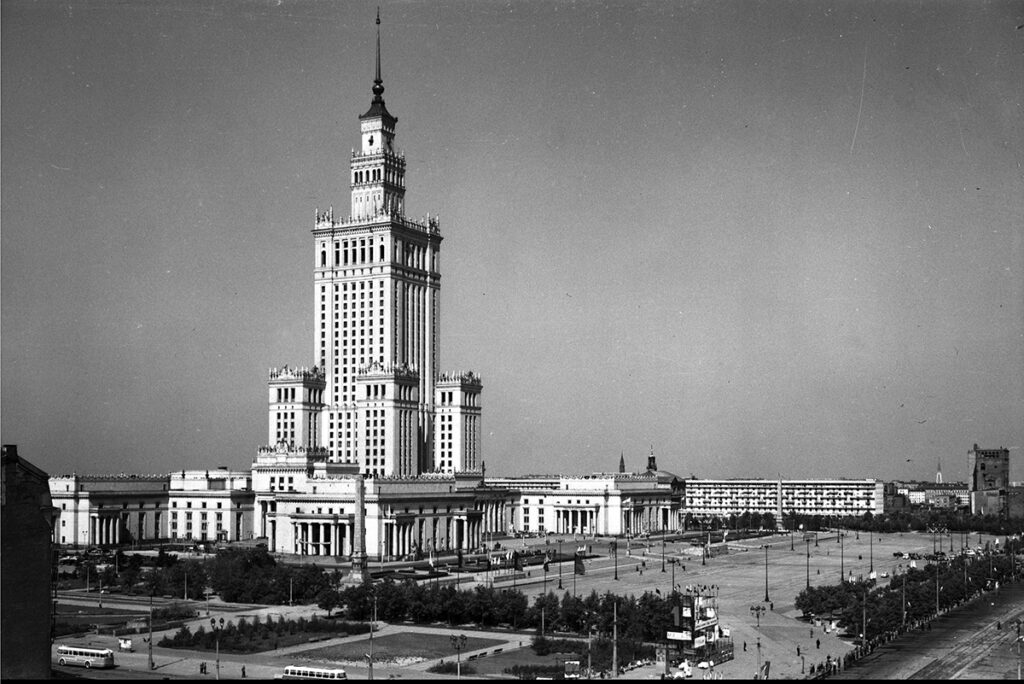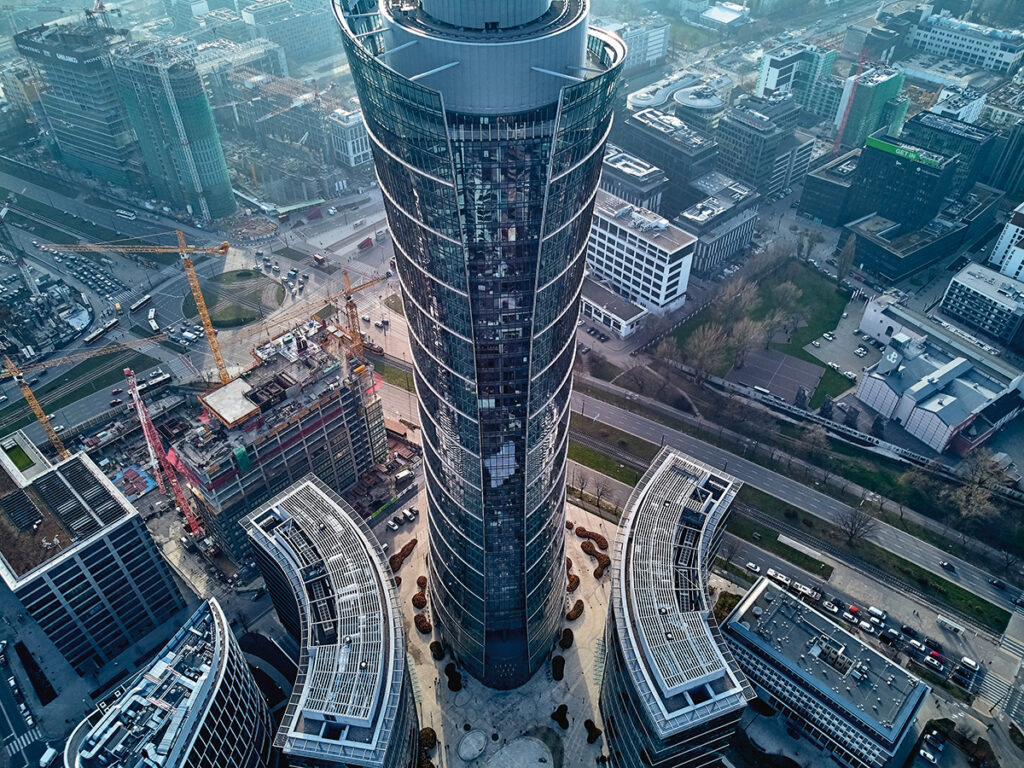The Opening Act
Commonly classified as Warsaw’s first skyscraper, when it was completed in 1908 the 11-storey PASTa on Zielna 37 was recognized as the tallest building in the whole of the Tsarist Empire – so impressed were they by its dimensions, it’s said that visiting out-of-towners would often stare up goggle-eyed as if hypnotized by the building’s power.

Inspired by the castles of the Middle Ages, it originally housed the Swedish telephone firm Cedergren before switching into the hands of Polska Akcyjna Spółka Telefoniczna (PAST).
Art Deco Swagger
On topping out, the 66-meter Prudential didn’t just become the highest building in Poland, but the second tallest in Europe – for many, it was a clear declaration that this was a city of the future. Built using two million bricks and two thousand tons of concrete, the Art Deco Prudential was constructed to house the Polish operations of the international insurance giant and was clearly influenced by the inter-war aesthetics of New York and Chicago.

Housing glitzy apartments at the top, it was also from here that the nation’s first TV broadcasts were transmitted in 1936. Later operating as a gloomy, state-run hotel, the last couple of years have seen it reopen as the luxury Hotel Warszawa.
Age of Destruction
One doesn’t need a history major to guess that the war didn’t bring about much that was good. Both of Warsaw’s pre-existing skyscrapers played iconic roles in the 1944 Warsaw Uprising, with PASTa cut off and surrounded by the Polish Home Army on the first day of battle.

A bitter siege ensued, culminating in fierce room-to-room fighting involving flamethrowers and hand-to-hand combat. Reports from the time speak of Nazi soldiers throwing themselves off the top floors to escape the chaos. Finally, on August 22nd, the German garrison defending it raised the white flag.

Likewise, Prudential was also captured on the first day of battle; pounded relentlessly by German forces, it survived all the Nazis could throw at it. Smashed by a 1,000 shells, including a 2-ton round from the dreaded Karl-Gerat mortar, the Germans failed to wrestle control of Prudential until the final surrender 63-days later.
From Russia With Love
The Gotham City aesthetics of the Palace of Culture & Science did much over the decades to lend Warsaw its reputation as a dour, dehumanizing town. Notoriously gifted to Poland by Stalin, this epic piece of Socialist Realist architecture continues to divide opinion, with many still viewing it as a symbol of subjugation – in fact, only a few years ago, plans were playfully touted to demolish it as part of a James Bond sequence.

Built in three years by 3,500 workers, this 50s mega structure has seen seismic events, from Marlene Dietrich storming out after a cat wandered onto stage, to The Rolling Stones causing a riot when they played in the 60s. Composed of 42-floors, 3,288 rooms and 40 million bricks (and defended from rodents by a unit of 13 basement-dwelling cats), it remains the most impactful piece of commie architecture in the country.
For The Masses
The ensuing years saw the execution of an aggressive plan to rebuild the capital, and this manifested itself by way of an array of often awkward blocks and towers.
A bold attempt to mold the socialist man through his environment, examples include the walloping Żelazna Brama housing estate in the center, an ugly collection of nineteen 15-storey high rise blocks built in 1965-72.

Then there was ‘the Eastern Wall’, features of which included a trio of residential towers facing PKiN from Marszałkowska. “Every night I have strong erotic experiences as a result of radiation from the television aerial on the Palace’s spire,” complained one female resident to a local newspaper. “This is extremely exhausting for me, so I hereby ask that the technological department conceals this aerial.”
Growing Up
It wasn’t until the 70s that the capital would receive its first ‘western’ style tower. The problem was, having decided to build a skyscraper in the first place, the government realized no one in Poland was qualified to do so. As such, the Swedes were called in, specifically architect Sten Samuelson. His creation, the Forum Hotel (now the Novotel), was unveiled on January 24, 1974.

Standing 96 meters in height, it was immediately installed as Poland’s second tallest building, and caused controversy aplenty. Locals nicknamed it ‘the chocolate bar’, thanks to its yellowish brown façade, while one critic, Jerzy Waldorff, went as far as to declare it Sweden’s revenge for their 1656 defeat at The Battle of Częstochowa. Most famously, ABBA kipped here in 1976. Since shedding its jaundiced skin, it’s gone a long way to being naturally absorbed into the skyline.
It’s A Curse!
If Pl. Bankowy looks unsynchronized and top-heavy then the primary culprit is ‘the Blue Tower’. One hundred and twenty meters in height, construction began during the ’60s, though was suspended once the bottom fell out of the Polish economy; in all, the building took a staggering 26 years to finish before being officially opened in 1992.

An enduring legend has it that this was only after a rabbi lifted a curse that had been placed on the land. Previously, the plot had been occupied by the Great Synagogue, a house of worship that had been the center of Warsaw’s pre-war Jewish community and whose destruction marked the final act in the suppression of the 1943 Warsaw Ghetto Uprising.
A New Dawn
The opening of the Marriott in 1989 wrote a new chapter in Warsaw’s skyscraper history. An island of American-style largesse and prosperity, expats and moneyed locals thronged the hotel’s bars and restaurants, while visiting VIPs made full use of the split-level Presidential Suite on the 40th floor: Joan Collins, Chris de Burgh, and so too Michael Jackson who allegedly switched here from the Bristol to flee the zoom lenses of the paparazzi.

Mostly, however, it’s the building’s association with the US Presidency that has made waves: Trump and Bush stayed here, whilst Obama was at the center of security storm after a guest managed to get up close and film him working out. In other useless trivia, four times its been conquered by climbers using no safety gear, among them “the French Spiderman”, Alain Robert.
The Wild 90s
A time of unhinged and unregulated capitalism, it’s fitting that Poland’s new freedoms bore witness to an explosion of gaudy, crass towers that reflected its Dynasty-style aspirations.
These included the 27-storey Central Tower which, on account of its then salmon and blue colored panels, quickly became established as one of Warsaw’s ugliest buildings, a title it held with pride till opting for a recent facelift; there was Ilmet, with its clunky styling and revolving rooftop Mercedes badge; and Wola’s original skyscraper, the 208-meter Warsaw Trade Tower which was built on the orders of Daewoo before their spectacular collapse.

But most notorious of all, there’s what’s now known as the Atlas Tower. Often likened to a portable toilet, a shower tub or, even, a Red Bull can in the grip of a vice, it was the brainchild of Vahap Toy, a controversial businessman whose plans for Poland included transforming the backwater town of Biała Podlaska into a Vegas-inspired resort complete with F1 track and Olympic stadium.
Yet on the subject of high-rise monsters, special mention must go to JW Construction. Often nicknamed JW Destruction, their Lego-block assemblies continue to cause widespread horror, perhaps most noticeably with their bewildering residential pyramid, Łucka City (2004).

Millennium Marvels
From the catastrophic architecture of the 90s, the millennium saw a more tasteful approach adopted with a host of winning ideas being realized. Featuring Europe’s highest pool, the 2003 InterContinental was built with a 15-floor indent so as not to deprive neighbors of sunlight, whilst the 2006 Rondo 1 won plaudits for its vertiginous transparency and panoramic lifts. Surprisingly, somewhat, it is two residential projects though that have seen the most fuss.

Delivered way over schedule due to the credit crunch (the good old days!), Daniel Liebeskind’s Złota 44 is a love or hate affair, with many critical of its overt vulgarity. Nonetheless, residents (who purportedly include Robert Lewandowski) praise its 10,000 bottle wine cellar, state-of-the-art recreational floor and design-forward fit-out, though to enjoy it yourself you’ll be spending a minimum of zł 25,000 per sq/m.

Then, nearby, there’s Helmut Jahn’s Cosmopolitan, a building whose 44-floors contain 236 apartments finished with Italian marble, oak wood floors and smart home management systems. A joy of simple form, it’s one of Warsaw’s favorite silhouettes.
For Business
Once a byword for urban stagnation and decay, the east rump of Wola has risen almost as if to resemble Delta City from the Robocop series. While the Warsaw Trade Tower acted as a precursor, it was the 2016 debut of the Warsaw Spire that truly lit the fire.

Redefining the corporate image of Warsaw, and winning the title of the world’s best business building at the 2017 MIPIM Real Estate Awards, the 220-meter super structure has since been joined by a raft of new neighbors such as the Mennica Legacy Tower, The Warsaw Hub I & II, Skyliner, Generation Park and the Warsaw Unit. Still more are in the pipeline, with the futuristic atmosphere offset by the numerous pre-war relics and atmospheric side streets.

Hitting New Heights
Warsaw’s ambition to be viewed as one of Europe’s financial big shots will be given a boost by the completion of the Varso Tower, a 53-storey project topping out at 310-meters. Designed by Foster + Partners, it’s set to become the EU’s tallest building and will include observation decks on the 49th and 53rd floor as well as Poland’s highest restaurant perched on Floor 48. As things stand, it should be completed at the end of the year.
